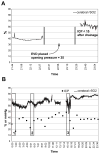Diagnosis influences response of cerebral near infrared spectroscopy to intracranial hypertension in children
- PMID: 19935441
- PMCID: PMC3675803
- DOI: 10.1097/PCC.0b013e3181c51cf1
Diagnosis influences response of cerebral near infrared spectroscopy to intracranial hypertension in children
Abstract
Objective: To describe cerebral regional oxygen saturation measured by near infrared spectroscopy in the setting of normal and increased intracranial pressure in children to evaluate the association between cerebral regional oxygen saturation and intracranial pressure in comparison with other clinical variables.
Design: Prospective observational cohort study.
Setting: Two academic tertiary care centers' pediatric intensive care units.
Patients: Thirty patients with intracranial pressure and near infrared spectroscopy monitoring (median age, 11.5 yrs; interquartile range, 5.2-13 yrs) for a range of neurologic diagnoses, including brain tumor, trauma, intracerebral hemorrhage, and hydrocephalus.
Interventions: None.
Measurements and main results: Temporally correlated cerebral regional oxygen saturation with hematologic (hematocrit), biochemical (pH), and physiological (intracranial pressure, mean arterial pressure, cerebral perfusion pressure, temperature, heart rate, pulse oximetry and end-tidal carbon dioxide) variables. Cerebral regional oxygen saturation during episodes of increased intracranial pressure was lower than with normal intracranial pressure (mean +/- sd intracranial pressure >20 = 71% +/- 13% vs. intracranial pressure <20 = 75% +/- 10%), although the mean difference (-4%) is small compared with variability in the measurement. Neither isolated values nor change in cerebral regional oxygen saturation were significantly associated with intracranial pressure or cerebral perfusion pressure in the overall population. Isolated values and change in end-tidal CO2 were significantly correlated with cerebral regional oxygen saturation and change in cerebral regional oxygen saturation (all p < 0.01). In exploratory analyses, the diagnostic group significantly modified the effect of intracranial hypertension on regional oxygen saturation: regional oxygen saturation decreased during intracranial hypertension in patients with brain tumors (p = .05) and hydrocephalus (p < .001) but increased during intracranial hypertension in those with intracranial hemorrhage (p < .001).
Conclusions: These data suggest that cerebral regional oxygen saturation is lower with intracranial hypertension. However, the relationship between cerebral regional oxygen saturation and intracranial pressure is strongly influenced by diagnosis.
Figures



Comment in
-
Near infrared reflectance spectroscopy--Farther than we thought?Pediatr Crit Care Med. 2010 Jul;11(4):535-6. doi: 10.1097/PCC.0b013e3181ce02b4. Pediatr Crit Care Med. 2010. PMID: 20606559 No abstract available.
Similar articles
-
Regional and central venous oxygen saturation monitoring following pediatric cardiac surgery: concordance and association with clinical variables.Pediatr Crit Care Med. 2007 Mar;8(2):154-60. doi: 10.1097/01.PCC.0000257101.37171.BE. Pediatr Crit Care Med. 2007. PMID: 17273125
-
Effects of Closed Endotracheal Suctioning on Systemic and Cerebral Oxygenation and Hemodynamics in Children.Pediatr Crit Care Med. 2018 Jan;19(1):e23-e30. doi: 10.1097/PCC.0000000000001377. Pediatr Crit Care Med. 2018. PMID: 29189639
-
The relation of near-infrared spectroscopy with changes in peripheral circulation in critically ill patients.Crit Care Med. 2011 Jul;39(7):1649-54. doi: 10.1097/CCM.0b013e3182186675. Crit Care Med. 2011. PMID: 21685739
-
Near-infrared spectroscopy as a hemodynamic monitor in critical illness.Pediatr Crit Care Med. 2011 Jul;12(4 Suppl):S27-32. doi: 10.1097/PCC.0b013e318221173a. Pediatr Crit Care Med. 2011. PMID: 22129547 Review.
-
[Indications for monitoring intracranial pressure].Ann Fr Anesth Reanim. 1997;16(4):415-9. doi: 10.1016/s0750-7658(97)81473-6. Ann Fr Anesth Reanim. 1997. PMID: 9750592 Review. French.
Cited by
-
Suppression of Electrographic Seizures Is Associated with Amelioration of QTc Interval Prolongation in Patients with Traumatic Brain Injury.J Clin Med. 2021 Nov 18;10(22):5374. doi: 10.3390/jcm10225374. J Clin Med. 2021. PMID: 34830656 Free PMC article.
-
Noninvasive Neuromonitoring Modalities in Children Part I: Pupillometry, Near-Infrared Spectroscopy, and Transcranial Doppler Ultrasonography.Neurocrit Care. 2024 Feb;40(1):130-146. doi: 10.1007/s12028-023-01730-4. Epub 2023 May 9. Neurocrit Care. 2024. PMID: 37160846 Review.
-
Pathophysiology and Treatment of Severe Traumatic Brain Injuries in Children.J Neurosci Nurs. 2016 Feb;48(1):15-27; quiz E1. doi: 10.1097/JNN.0000000000000176. J Neurosci Nurs. 2016. PMID: 26720317 Free PMC article.
-
Usefulness of Cerebral Oximetry in TBI by NIRS.J Clin Med. 2021 Jun 30;10(13):2938. doi: 10.3390/jcm10132938. J Clin Med. 2021. PMID: 34209017 Free PMC article. Review.
-
Application of optical methods in the monitoring of traumatic brain injury: A review.J Cereb Blood Flow Metab. 2016 Nov;36(11):1825-1843. doi: 10.1177/0271678X16667953. Epub 2016 Sep 7. J Cereb Blood Flow Metab. 2016. PMID: 27604312 Free PMC article. Review.
References
-
- Blaha M, Lazar D, Winn RH, Ghatan S. Hemorrhagic complications of intracranial pressure monitors in children. Pediatr Neurosurg. 2003;39(1):27–31. - PubMed
-
- Guyot LL, Dowling C, Diaz FG, Michael DB. Cerebral monitoring devices: analysis of complications. Acta Neurochir Suppl. 1998;71:47–49. - PubMed
-
- Zabramski JM, Whiting D, Darouiche RO, Horner TG, Olson J, Robertson C, Hamilton AJ. Efficacy of antimicrobial-impregnated external ventricular drain catheters: a prospective, randomized, controlled trial. J Neurosurg. 2003;98(4):725–730. - PubMed
-
- Robertson CS, Narayan RK, Gokaslan ZL, Pahwa R, Grossman RG, Caram P, Jr, Allen E. Cerebral arteriovenous oxygen difference as an estimate of cerebral blood flow in comatose patients. J Neurosurg. 1989;70(2):222–230. - PubMed
-
- Madsen PL, Secher NH. Near-infrared oximetry of the brain. Prog Neurobiol. 1999;58 (6):541–560. - PubMed
Publication types
MeSH terms
Substances
Grants and funding
LinkOut - more resources
Full Text Sources
Other Literature Sources

